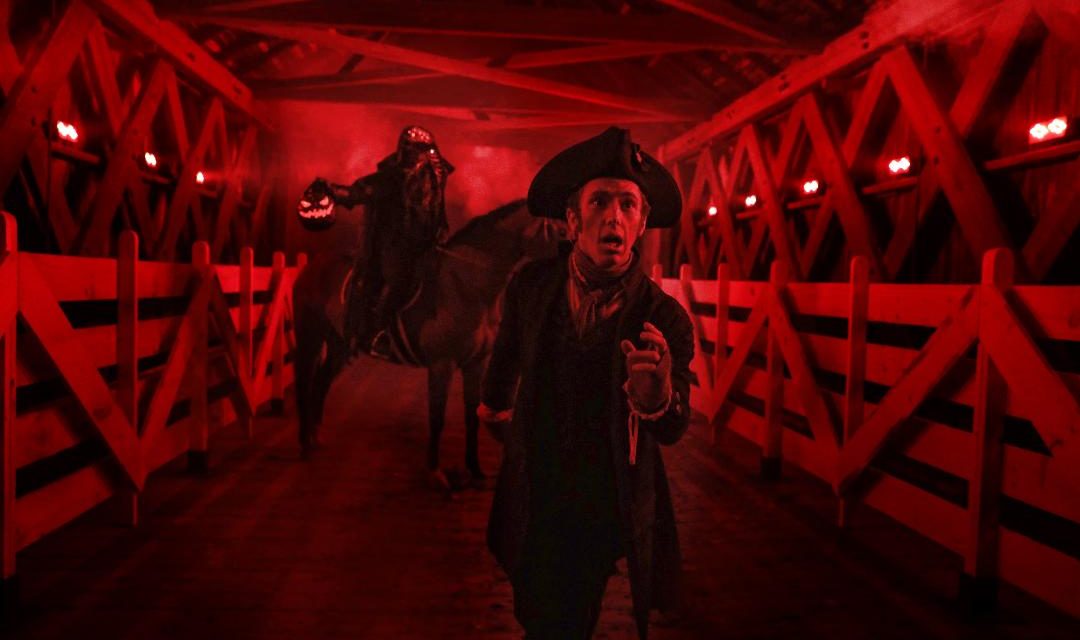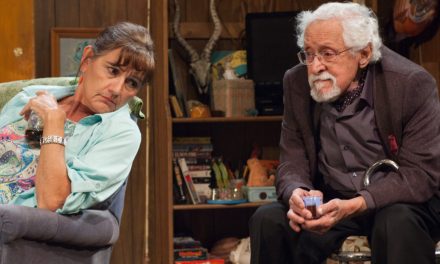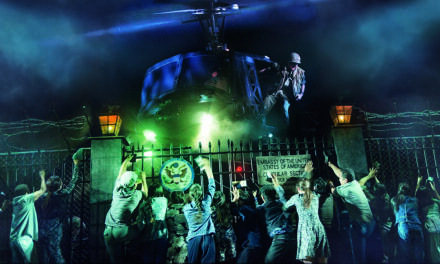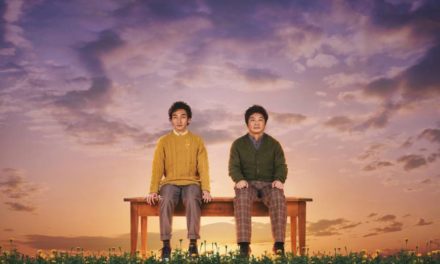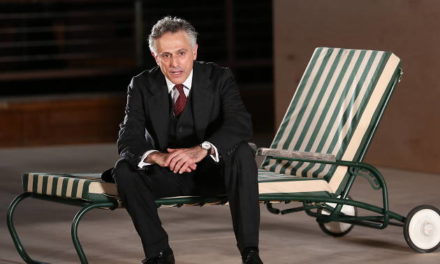Brian Clowdus was left burned out and unfulfilled as a hustling actor. On a whim on his way back home, he visited Serenbe, Georgia and felt an immediate connection to the area. Following his gut, he proposed a plan for a playhouse that would eventually become one of the top emerging regional theatres in the country. Although not the initial plan, the lack of physical space drove Clowdus to create art outdoors. Utilizing this radical concept, he became nationally known as a leading outdoor site-specific producer and the Founding Executive and Artistic Director of the Serenbe Playhouse.
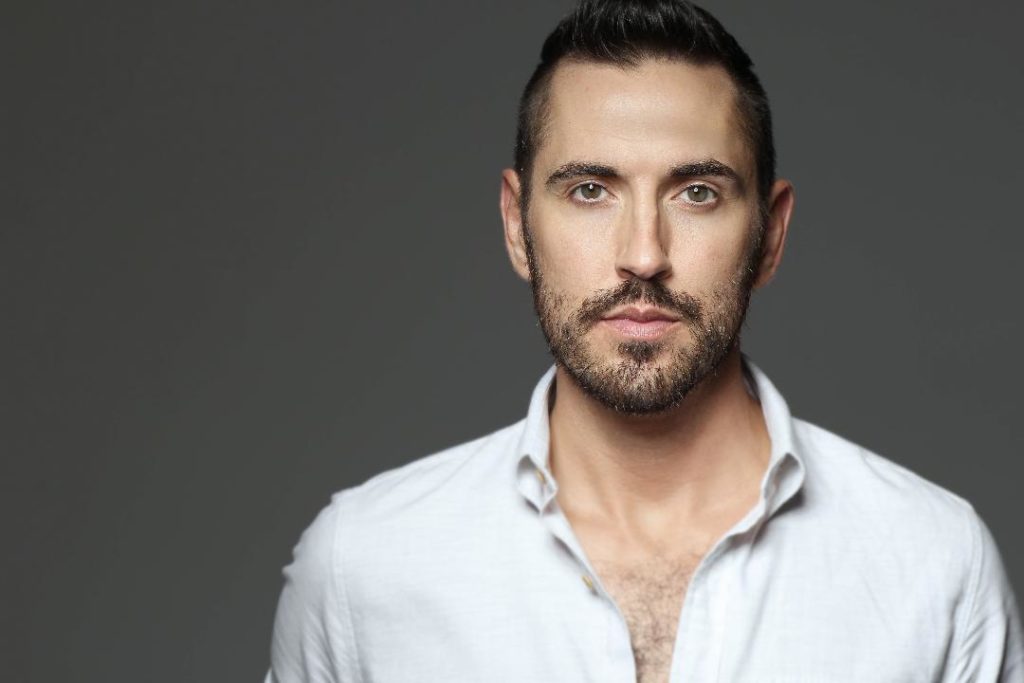
Brian Clowdus. Photo Credit: BreeAnne Clowdus
Rickey Orr: How big is the Serenbe area where you produce productions?
Brian Clowdus: Serenbe is a 1000 acres, which is not very huge, you know. But the way the community is set up, only 33% of it is developed, so the other two-thirds are green space. I have all of this acreage to pop up shows in. I’ve got all of this to make stuff happen in, but relatively speaking the community is small.
What has been the impact on the surrounding community?
In Serenbe, it’s been pretty huge. It’s affected the immediate community of Serenbe. It’s affected our twenty-mile radius and then even into Atlanta. We’re seeing 50,000 plus people a year and Serenbe has like 600 residents. The amazing thing is that we’re pumping that many people in this tiny community, and we’re putting art in their backyard, but also we’re a huge business for them. All those people who come see the shows, they go into the restaurants, and they go into the boutiques, and they stay at the inns. So, I mean it brings a lot of value to the community and the surrounding area.
Okay. So you’d say it’s really been able to bring the community together and support it [the Playhouse] even more?
Yeah, man. I think that’s the beauty of theater, right? It’s a community builder.
Will Serenbe playhouse ever do site-specific immersive productions anywhere other than outside of Atlanta, Georgia?
Well, I’m doing that now through my other company. I have two companies. I have Serenbe Playhouse, which is the non-profit, and I have Brian Clowdus Experiences, which is my for-profit company, and I’m doing a lot of that right now. So basically, it’s the same model and same type of work that I’m doing, but on a commercial scale. I’m actually talking to you in Ohio right now, [laughs]. Ya, so I just opened my third Sleepy Hollow. So, there’s the one in Serenbe running; and then I have one outside of Boston, and I just opened one this year outside of Columbus, Ohio. So, I’m taking the model of what I’m doing in Serenbe and expanding it on a national level. It’s awesome for me to kind of balance, both of those missions, you know.
What made you decide to create Brian Clowdus productions?
I wanted more money. I mean, let’s be real. You know, non-profit works. I am salaried through the non-profit; and when you work your non-profit, there is a cap on how much money you can make. Brian Clowdus Experiences spun off of people organically asking me, “Hey will you come to my community and mount a production?” And I was like, “Well sure if you pay me.” You know, what I mean? That’s always my answer. Actually, I just launched my new website. If you go to brianclowdus.com, you will see all of the other work I’m doing outside of Serenbe.
What is the Sleepy Hollow Experience?
It’s an immersive version of Sleepy Hollow, and you literally are following the actors all the way around. There are some live horrors. There’s actors who sing. You follow them through the woods. So, it’s really cool. It’s almost like a high-end haunted trail.
What was your process behind landing a helicopter for Miss Saigon or with this past production of Titanic having the ship sink into the lake?
Well, first of all, you have to choose the site. I always say that the material and the location (where) we do the productions are just as important. So, it’s a marriage of choosing the right environment and getting the right material that works for that environment. And, then you have to get the right people in the room. All those people, who are making the vision happen. Logistically, we’ll choose the site, and designers will design it. The technicians will start building it, and then we’ll be indoors for the first couple of weeks rehearsing, and then we move to the site, and it’s like a puzzle. It’s putting all the pieces together, and a huge element of it is this idea of groundbreaking work. It’s also very dangerous. We had actors literally flinging themselves off the fourth story of a ship. It’s extremely dangerous, but we have a whole safety crew and a stunt man. It’s just with the bigger the vision and the more groundbreaking of the work, the earlier you have to start and the more prepared you have to be. There were several rehearsals that all we did was address safety. Hours and hours of just talking about safety protocol. How does all of this happen very safely?
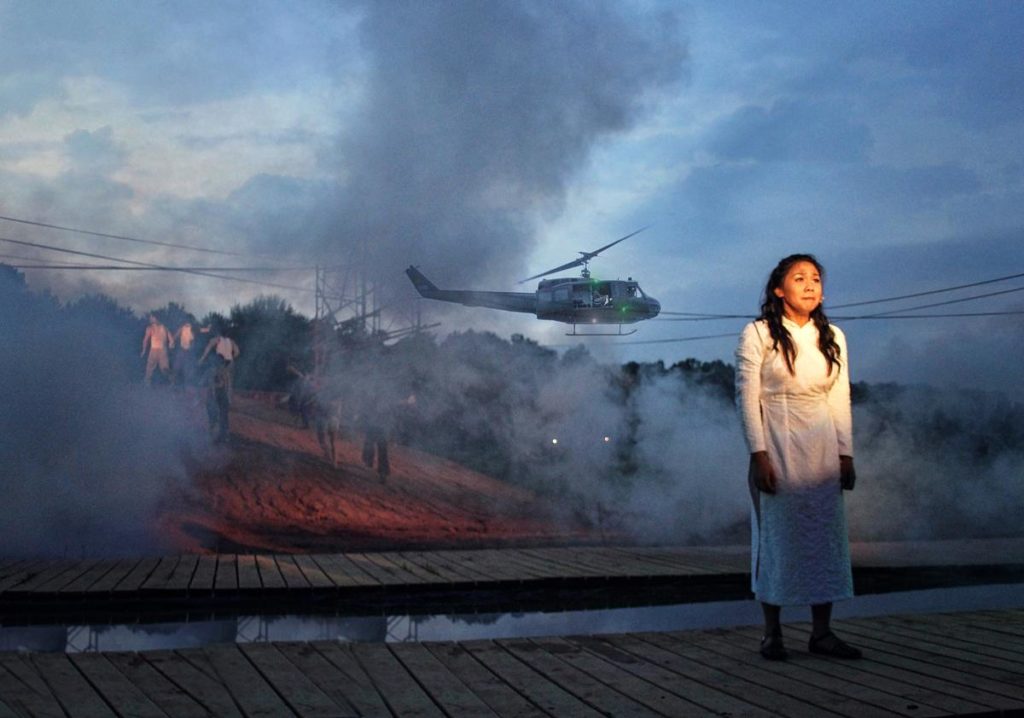
Miss Saigon Serenbe Playhouse. Photo Credit: BreeAnne Clowdus
And then what resources does it take in order to do this work?
Money. It takes a lot of money, and it takes a lot of work. That is literally the secret. I mean you have to be talented. I’m talented. I’ll be the first to say it, but I have a big vision. But, it takes money and time. Honestly, that’s what I always say. I’m always like, “Oh, if I only had a little bit more money or if I only had a couple of more days.” But, I think it’s also important to have boundaries, because if I had an unlimited pool of money, it might not be good. Or, if I had an unlimited amount of time, I would work every single minute. That’s the beauty of theatre, that is you have a budget and you have an opening night. So guess what? You have some restraints. As an artist, I think it’s important to create restraints for yourself or else you just keep going and going.
What has been your favorite production that you’ve done so far?
I always say it’s the one I’m currently working on. [I say, “Oh.” and laugh] I know that sounds cheesy, but I don’t have a favorite. Whatever show I’m currently working on becomes my absolute favorite. For me, I’m always looking at how do I top the next one? In Serenbe, it was Titanic. It was the biggest thing we’d ever done. It got the most national buzz. So, now I’m looking towards next season, and how do I top it.
How do you choose the themes for each season, such as “VOYAGE–after the rebellion WE SAIL ON!” which is the current one?
First of all, I love a theme. I think it helps marketing. I also think for me personally, it helps me choose a cohesive season. So, typically I will choose what I call the anchor show; and for this season, it was Titanic. So, I knew Titanic was the show I had to do this year. It was like my heart was telling me to. And, I’m real big on following your gut, following your heart, because I just think, I think that is where great things come from inside, you know. So, when we got the rights for Titanic, then I built the rest of the season around Titanic, and or me, it was really about embracing logger and this idea of voyaging somewhere. So then, you know, I got this huge list of shows that I want to eventually produce. This laundry list of shows I love, and I just visit that list every once in a while and kind of pace and pull shows together that fit within what I call the anchor show. But, for this past year, it was Titanic and that helped us put the Voyage season together.
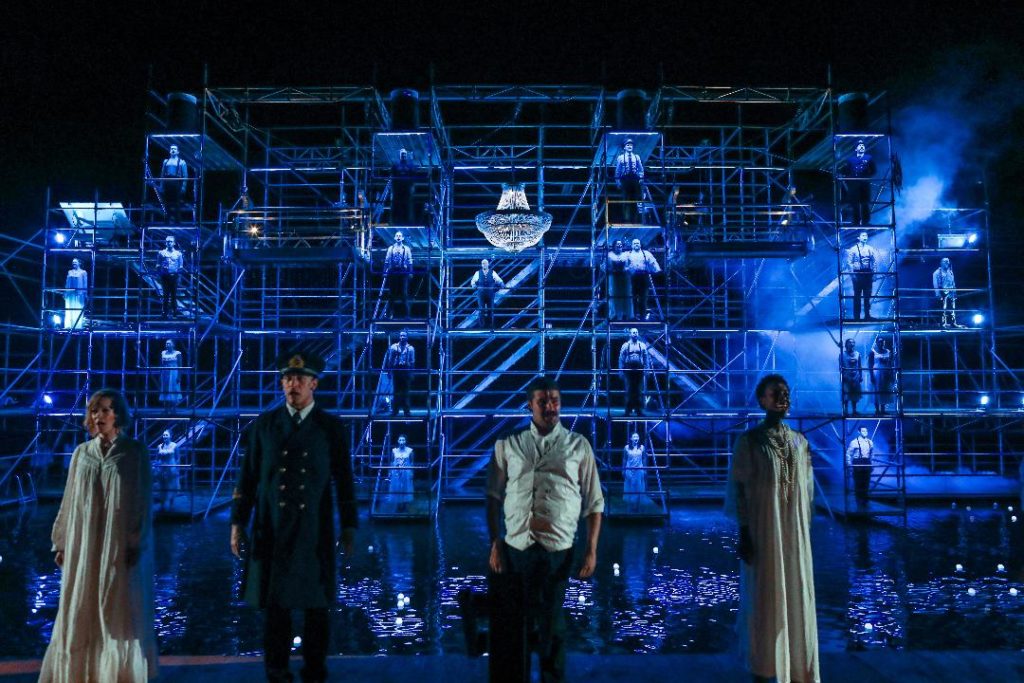
Titanic Photo Credit: BreeAnne Clowdus
Do you ever look for anything particular within shows when going through show selections? For example, if they can be done outdoors [of course], but do you look for anything else in them?
The first thing I look for is a good story. I mean I’m a storyteller. That’s my profession. I tell the human story. For me, I have to be connected to the story. Then the second thing is how can I reinvent it? That’s what I’ve kind of become known for, reinventing work and that can be either making it sort of edgier and younger and fresher, or it can be reinventing the environment that the story is told in. I’m always looking at how can I reinvent material. That’s what gets me excited.
What has been your biggest takeaway from leading the Serenbe Playhouse?
If you want to start any company that’s successful, it has to be your life. You have to eat, breathe, and sleep the company, and you have to sacrifice. It has to be the most important thing in your life. I mean, it truly does. I wake up and the first thing I do is look at my phone and email. I go to bed. The last thing I do is email. It has to be so integrated into your life, but that’s true for any entrepreneur who’s starting something from the ground up. The work I’m doing at Serenbe and now nationally, it’s what I do. I’m not in a relationship. I put all my energy into this, and I love it. It makes me super happy. The amount of work you put in is what you get out…but as an artist, to be one hundred percent in control of my career and how much money I make and what my life looks like, it’s pretty rare, but I have worked my booty off to get here. It doesn’t happen overnight. That’s what I always say, “It doesn’t happen overnight.”
What was a teachable moment that you came across that changed how you approach things now?
A teachable moment? [long pause] I guess a really teachable moment is like choosing your battles, you know. I think that as a young leader, I mean I’d like to consider myself still a young leader. But you know, ten years ago when I started the playhouse, I would get very upset and very emotional about everything. I would take things very personally and things that really affected my core and hurt my feelings. I got to the point as a leader where I know this sounds a little harsh, but I just became a little hard, but in a way where…it takes a lot to truly get me upset now. So I’m a lot calmer than I used to be, and in theater, there’s always gonna be things that don’t happen and things that get behind. Now I am able to be calm and really focus on what battles I need to go after. You have to pick your battles. I think that’s something that all theater makers need to really know. You’re not going to get everything you want in a production, but there are some things that I know I’m absolutely not willing to compromise on. So, you really have to pick your battles and stay calm about the little stuff that does not matter.
I noticed as I went through your website that you provide apprenticeships for people, who have just graduated from college and that you do K through 12 theater classes. Would you say that is your education outreach?
Yes. Part of our mission in theatre is a necessity, not a privilege. We do a lot of donated performances to school groups that can’t afford to come because I came from a very poor upbringing in Alabama. So, I always have a really soft spot for kids that can’t afford theatre. I think it’s very important to give back. I also have a really soft spot for young emerging artists, because I was a young, hungry, emerging artist, and I love giving young people opportunities. Our year-long apprenticeship is a way for emerging young artists to come in and work alongside us. I’ll give you an example. Our stage management apprentice last year at Serenbe is now my lead stage manager on Sleepy Hollow in Ohio. It’s sort of an incubator for talent. My goal is that they mesh well with the work that we’re doing, and then I give them professional jobs after their year.
Also, your website says that you produce shows with a commitment to sustainability. How do you achieve that with each production you produce?
We try to use as much LED lighting as possible, which uses a fraction of the energy that standard theatrical lighting does. We try not to build things and throw them away. The majority of the Titanic set was actually made out of construction scaffolding, which was rented and put together. Despite how massive that set was, almost none of it ended up being thrown away. We’re always thinking of how do we build things that are recycled or that we can reuse again.
Do you ever hope to create an outdoor, immersive experience on Broadway, if possible?
I’ll be honest, it’s not my end goal. Sure it would be great, but I’m so happy doing…I have so much work right now (that) I truly cannot keep up with it. There is so much happening, in a good way, that I am at my, “Oh gosh how do I put more hours in the day?” When I was younger, I thought the end goal was Broadway, but it’s really not. I think that some of the most interesting work is being done outside of Broadway, and I feel a little closed in when I go into a standard theatrical environment. It feels a little stifling to me. It is interesting to see how shows like The Great Comet have kind of shaken up how indoor theater is done in New York. But it’s honestly not the end goal for me anymore. I think that I love going into communities that don’t have access to theatre and popping something up in their communities. That’s really what I love, and that’s really where I want to expand.
You mentioned going into communities that don’t have access to the arts and then bringing theatre there. When you work with children or even adults in those communities, do you ever find that you are their first access to theater?
Yes, tons, tons. You’d be surprised how many people don’t go see theater. They sit at home and watch TV and play video games.
You also mentioned the traditional aspect of theater and not working along that. So, in your productions do you find yourself not playing to the traditional proscenium design and things, such as that?
Yeah. there’re no walls. It’s theatre without walls and without ceilings. So there’re no rules. You make your own.
In regards to mounting outdoor productions, is there anything you have thought of that you could not do, but still want to try and achieve one day?
No, I’m doing everything I want to. [I say “Oh.”] I know it sounds crazy, there’s nothing where I am like, “Oh I wish I could do this.” I just do it. I wanted to land a helicopter, so I did it. [I laugh] I wanted to sink a ship, so I did it. I really get sick and tired of people giving excuses as to why you cannot do something. I’m looking for every reason why I can do it, and I’ve been told “No” so many times, but I don’t let it affect me. I always say no is an opportunity for a conversation and as long as people are telling me “no,” they’re still engaged. With the helicopter from Miss Saigon, I was told “No” for months, that it would never happen and that I was a crazy person. Guess what? It happened. I always felt for months that there would be no way to throw actors into a lake in Georgia for Titanic. But guess what? It happened. I think my greatest talent is sustaining a vision and not taking “No” for an answer. I just refused to take her.
What is your plan or hope for the future of Serenbe and your career?
It’s to keep expanding what I’m doing. To take the productions to a larger scale and to involve more artists. To take this idea of site-specific, immersive theatre or experiences to other communities across the nation or even internationally, and expand, expand. This idea of theatre does not live inside or in a box. Theatre can live anywhere and it is really a tool to bring communities together and to give access to art where there isn’t access.
This post was written by the author in their personal capacity.The opinions expressed in this article are the author’s own and do not reflect the view of The Theatre Times, their staff or collaborators.
This post was written by Rickey Orr.
The views expressed here belong to the author and do not necessarily reflect our views and opinions.

